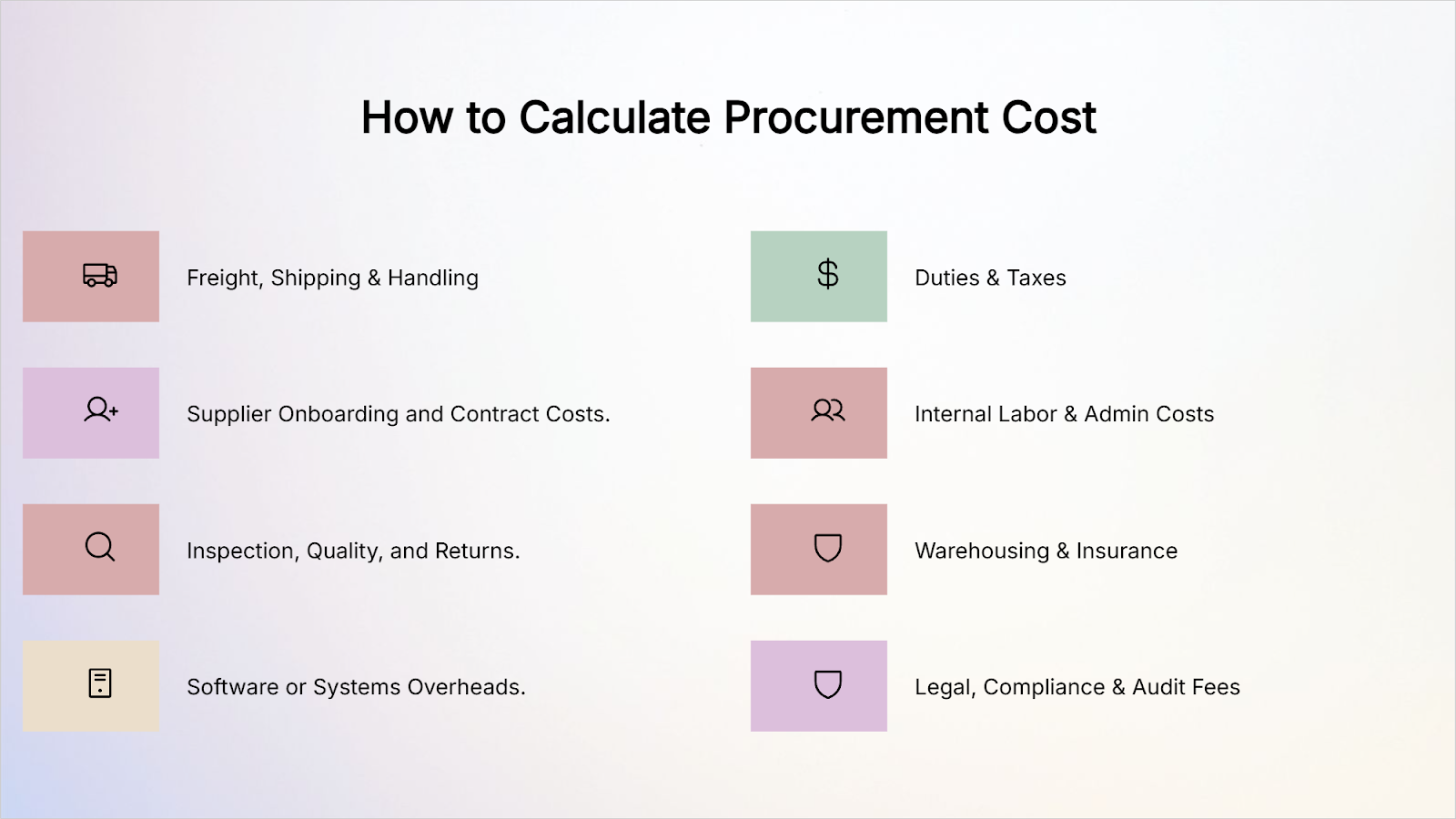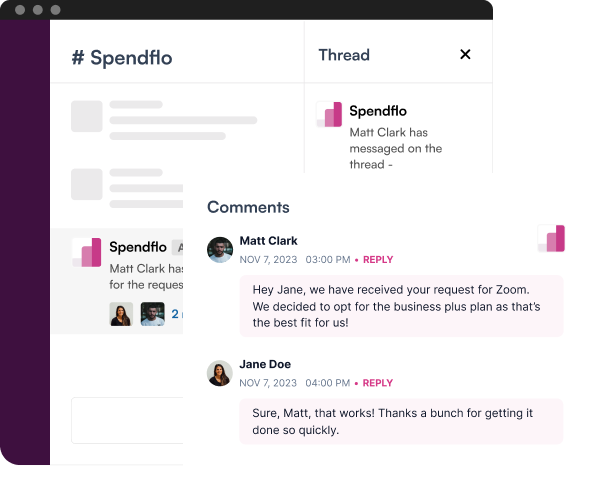

What Are Procurement Costs? Importance & Best Practices

What Are Procurement Costs? Importance & Best Practices
Learn what procurement costs include, how to calculate them, and best practices to cut expenses and boost efficiency with automation.


According to research by McKinsey & Company, procurement often accounts for more than 20 percent of the total financial impact in a transformation program.
If you feel like you know what you’re paying for goods or services but don’t have a clear view of the real costs involved in acquiring them, you’re not alone. Procurement costs go far beyond the base price of everything you buy. They include sourcing, purchasing, storing, shipping and supplier management. When you understand all of these, you’re better placed to manage spending and improve business outcomes.
What Are Procurement Costs?
Procurement costs include all expenses involved in purchasing goods or services beyond the supplier’s price. They cover raw materials, transportation, inventory, contracts, and administrative expenses, along with supplier relationship, risk, quality, and technical costs. Effective procurement means understanding every cost driver, from bid preparation and vendor fees to project infrastructure and unapproved spending. With AI-driven spend analytics, companies can improve visibility, reduce costs, and strengthen overall cost control.
Procurement Cost vs. Product Cost
It’s easy to confuse procurement with product cost, but they measure two very different things. Product cost is what you pay to buy the item itself. Procurement cost covers everything it takes to get that product ready for use from sourcing and contracts to delivery and inspection.
Here’s a simple comparison:
Suppose that your firm purchases 1,000 software licenses priced at 100 dollars. The product cost is $100,000. However, the cost of the procurement is increased by $10,000 in taxes and shipping, $5,000 in legal and onboarding costs, and $3,000 in administrational costs, bringing the total procurement cost up to $118,000.
This additional 18,000 US dollars reveals the undisclosed cost of each purchase. Understanding this assists finance and procurement teams to make superior sourcing decisions, negotiate smarter and identify areas where time and money are being squandered.
How to Calculate Procurement Cost
You must calculate your Total Procurement Cost (TPC) to know how much you are actually spending within your company. And this is beyond the invoice of the supplier. It involves all the costs associated with making a product or service into your hands.
Total Procurement Cost =
- Supplier Price
- Freight, Shipping & Handling
- Duties & Taxes
- Supplier Onboarding and Contract Costs.
- Internal Labor & Admin Costs
- Inspection, Quality, and Returns.
- Warehousing & Insurance
- Software or Systems Overheads.
- Legal, Compliance & Audit Fees
All these are contributing to your true cost of procurement. An example of this is the onboarding of a new supplier and would consume time of your legal, finance, and procurement division. The time is an internal labor expense. The same applies to the tools and systems you operate to manage the vendors or keep track of orders which fall under the software or systems overheads.
If you want to check efficiency at a granular level, use this formula: Procurement Cost per Unit = Total Procurement Cost ÷ Number of Units Purchased
Let’s look at an example.
Imagine your company spends:
- $50,000 on supplier prices
- $5,000 on freight and taxes
- $2,000 on admin and labor
- $3,000 on software and compliance
That will make your Total Procurement Cost $60,000.
Assuming that you bought 12,000 units, your Procurement Cost per Unit would be 5.
Cost per Order or Cost per Invoice can also be calculated to know how efficient the processes were. When these costs appear to be excessive, it might imply excess manual approvals or absent data decelerating the process. The regular review of these numbers can give you an idea of what waste can be eliminated by automation or centralized workflow and how much better you can have control over your spend.

Best Practices for Managing Procurement Costs
Procurement cost management is not merely price reduction. It involves enhancing visibility, process tightness, and developing enhanced control throughout the spend cycle. These best practices assist a team to remain productive and make better financial choices.
1. Centralize Vendor Data
Keep all the supplier items such as contracts, quotes and renewal dates under one roof. The centralized system simplifies monitoring of commitments, vendor comparisons and eliminates duplicates. When all people are working with the same data, it will make the process of decision-making quicker and more accurate.
2. Automate Routine Work
Paper invoices and manual approvals of purchase requests are slow and prone to mistakes. Purchase requests, approvals, and payments are automated thus conserving time and administration costs. It also guarantees that all transactions are captured so as to enhance compliance and audit preparedness.
3. Negotiate Proactively
Begin to review agreements and prices long in advance of renewal dates. Initial bargaining will allow you time to consider, compare and better the terms. This will eliminate the rush jobbing of renewals and will also help you not to be bound to the high-cost deals.
4. Consolidate Suppliers
It is too difficult to deal with a number of vendors, and your bargaining power is limited. The consolidation of the suppliers will help in negotiating larger discounts and making the renewals of the contracts easier. It also minimizes the invoices and it enhances the relationship with the vendors who are important.
5. Track Actual Usage
Continuously compare what you pay against what your teams consume. This is particularly essential in the case of SaaS tools and recurring services. Use history helps in the identification of unused goods or unnecessary subscriptions that may be done away with in order to reduce expenses.
6. Standardize Processes
There are standardized procedures and processes that ensure procurement is predictable and organized. Clone intake forms, approval rules and vendor evaluation steps between departments. This simplifies the compliance, accelerates the cycles, and examines the spending patterns.
7. Prioritize Cost Avoidance
Preventing waste is more advantageous than recovering the waste at a later stage. Check the purchase requests with scrutiny to make sure it is in line with the company objectives. Find areas of overlap or wasteful spending that can be prevented by checking budgets prior to contract renewals.
8. Run Quarterly Reviews
Conduct frequent procurement reviews, rather than annual reviews. Reviews in a quarterly basis, aids in monitoring the tendencies of expenditures, reorganizing budgets, and renegotiating the terms with the vendors in advance. This ensures that your procurement strategy keeps abreast with the evolving business needs.

How the Intake Process Impacts Procurement Cost
The way employees present purchase requests and the intake process directly affect the overall procurement costs. An efficient and similar process ensures that requests are accurate, approvals are fast and spending is kept under check. Messy or inconsistent intake will translate to delays, confusion and increased costs throughout the board.
Poor or ambiguous requests
This occurs when employees do not provide sufficient information in a purchase request whereby the procurement team has to follow up on information subsequently. This back-and-forth slackens approvals and means taking more time per order. The additional time of the various teams sums up and increases the actual price of every acquisition.
Structural discrepancy in request forms
Unless various teams have their templates or forget to follow important steps such as budget validation, reviews will be complex. The absence of the data or non-standard forms complicate the process of the request assessment by approvers. This irregularity prolongs the cycle times and augmented administrative efforts.
Missing or incorrect data
Without all the information, procurement teams are usually unable to make purchase orders. Lack of supplier information, cost centers, or approval notes cause manual follow-ups, which postpone the delivery. Every delay translates to increased time per transaction and decreased turnaround on business critical needs.
A structured intake process ensures:
- Everything required is captured at the initial stages: The standardized forms gather important details of the department, budget code, supplier, and justification, and then proceed with the request. This eliminates the omission of information that brings about delays downstream.
- The requests go out to the appropriate approvers automatically: Automated routing This makes sure that each request is sent to the right budget owner or department head. This removes the problem of confusion regarding the person to approve and hastens the decision-making process.
- Full visibility of the future spend is achieved by procurement: A centralized intake system provides procurement with a clear picture of the intended purchases prior to the occurrence. This assists in predicting cash flow, how to negotiate better deals and avoid unexpected costs.
A clean, structured intake process reduces errors, improves collaboration between teams, and shortens procurement cycles. The result is faster approvals, fewer budget overruns, and lower total procurement costs.

How Spendflo Helps Reduce Procurement Costs

Modern procurement can feel scattered, slow, and expensive. When vendor details live in spreadsheets and approvals sit buried in inboxes, teams waste hours chasing clarity. Spendflo brings everything together in one place. It centralizes vendor data, purchase requests, approvals, and payments, which means no more information sprawl.
With intelligent, rule-based automation, Spendflo reduces manual effort and delays, ensuring every request moves smoothly through budget and compliance checks. Finance and procurement teams gain live dashboards showing real-time spend, upcoming renewals, and opportunities to save. The result is faster, more confident decision making.
Spendflo also helps businesses identify duplicate vendors and overlapping subscriptions, allowing them to consolidate contracts and negotiate better terms. By streamlining the entire supplier lifecycle and creating full visibility into spend, organizations often save up to 30 percent on procurement costs.
If your team is ready for a more transparent, efficient, and cost-effective procurement experience, Spendflo can help.Book a demo here.
Frequently Asked Questions
1. What are common components of procurement cost?
Procurement costs entail more than what you give to suppliers. They include supplier prices, shipping, and handling, duties and taxes, and internal workforce to oversee approvals or onboarding. Storage, software subscriptions and compliance or audit fees should also be included in you. These add up to the total cost of acquiring and maintaining goods or services.
2. How is procurement cost different from product cost?
The procurement cost and the product cost are two of the measures used to provide the overall cost of buying and managing a purchase and the cost of making or buying the item itself respectively. As an illustration, product cost would consist of the raw materials or unit pricing but procurement cost will be in the form of freight, taxes and time spent in the administration. Knowing one and the other would enable you to see the real expense of ownership.
3. How can I calculate procurement cost per unit?
In order to determine the procurement cost per unit, one will begin by adding all the costs that are associated with the procurement process, including supplier price, shipping, labor, software, and compliance costs. Thereupon divide that sum by the amount of units or transactions made. That will assist you in estimating the actual cost of every purchase and where efficiency can be made.
4. How do I reduce procurement costs effectively?
To reduce expenses you can centralize the vendor and contract data in such a way that it can be easily accessed and followed. Manual work is minimized through the automation of purchase requests and approvals and accelerates cycles. This is because by regularly reviewing the contracts with the suppliers, you can spot pricing opportunities and by analyzing what you spend, you can identify where you can cut down on this.
5. Why does intake matter in procurement?
The procurement process is defined by the intake process that determines the efficiency and smooth running of procurement. In a structured and complete request, the teams waste less time in seeking details and approvals are expedited. An effective intake system will also avoid multiple purchases and the finance a better view of intended spend will assist in managing costs throughout the organization.










.png)




.png)



%20Questions%20to%20Ask%20Vendors.webp)

%20Systems%20A%20Comprehensive%20Guide.webp)




.avif)





